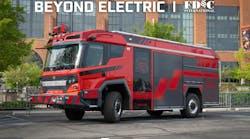Overhaul is a mainstay of thermal imager (TI) usage. The TI, even in its earliest forms, helped firefighters identify hot spots or hidden fire. In fact, in the late 1990s, it was common to hear of fire departments that used their TIs almost exclusively for overhaul. While times have changed, and fire departments have expanded the usage of thermal imagers, overhaul still remains a key application. It is also an application that can present certain challenges to you as a firefighter.
When Is a Hot Spot Hot?
Your job during overhaul is to locate and extinguish all potential hot spots. This helps prevent rekindles, which can cause you to be re-dispatched to the same location, as well as potentially cause additional damage. The catch, of course, is that after a fire, much of the area near the fire will appear hot on the TI. To successfully use a TI in overhaul, you must know how all the options on your TI function, as well as how to make comparisons.
Your TI may be equipped with a number of options or features that can help you identify "true" hot spots. If you are using a ferroelectric, or BST-based thermal imager, the most obvious indicator is the "halo." This is a black ring that appears around objects that are extremely hot, in comparison to the rest of the scene. During overhaul, you should concentrate first on those areas indicated by halos. In photo 1, the square vent on the wall is bright white with a black halo around it. This vent served as a conduit for heat transfer during the fire, and therefore is extremely hot in comparison to the walls in the room. This spot deserves your attention first.
If you are using a microbolometer-style TI, the two most common features are colorization and temperature measurement. Know how the colorization works on your thermal imager. Some models will have colors activate at only one temperature (say, orange at 800 degrees Fahrenheit); others may have the same color activate at different temperatures (say, red from 225F to 250F and then again after 900F). Some allow you to introduce color to pinpoint which areas are hotter than others.
Most microbolometers also include temperature measurement. This system makes an estimation of the surface temperature of an object. Remember that these systems are rarely 100% accurate, but they can help you determine hot spots. For example, if one area of drywall is showing temperatures near 200F and the area to the left of that is showing temperatures near 150F, even though the temperatures may be slightly inaccurate, in relationship to each other, they are reliable and you should start with the 200F area. All systems have advantages and you need to know what type of system your TI uses and how to use that system to help you with overhaul.
What If I Am Not Sure?
Sometimes, the thermal imager may just make you wonder if an area is hot enough to rekindle. After all, not everything will be obvious. In this situation, resort to common sense and old-fashioned methods. If the area could have been exposed to fire or convected heat, then your concern should be greater than if it is just an uninvolved area near the water heater. You can use plain old human touch to help identify areas that are warm and areas that are hot. Inspection holes are still viable options as well; sometimes making a small hole to take a quick peak behind a wall will tell volumes. Obviously, if you find charring or smoke behind the wall, you should probably do more investigation. If you find the pipe to the second floor radiator, then you might not want to tear the rest of the wall apart.
When you are comparing areas, be sure that the areas are in the same scene. By this, I mean you cannot compare the wall in the living room to the wall in the bedroom. The TI will make adjustments to the overall scene, and because these two areas have different heat signatures, you cannot compare these walls. You can, however, compare walls within the same room. You will get the most accuracy by comparing objects in the same image.
Conclusion
Overhaul with a thermal imager can be a difficult task. By practicing regularly with your TI, and understanding all of the special features on your TI, you can make better decisions about when and where to overhaul. Common sense, of course, should always be at the forefront of your analysis. For more tips on evaluating scenes for overhaul, please visit the Technology section of Firehouse.com.
JONATHAN BASTIAN is a thermal imaging specialist for Bullard. He is certified as a thermal imaging instructor by the Law Enforcement Thermographers' Association (LETA). He is also the author of the FD Training Network "FireNotes" book, Thermal Imaging for the Fire Service. Bastian served 12 years on the North Park, IL, Fire Department, including the last three as a captain. He has taught classes on thermal imaging, rapid intervention teams and search and rescue operations. He is currently a public safety official in Central Kentucky. If you have questions about thermal imaging, please send them to [email protected].





